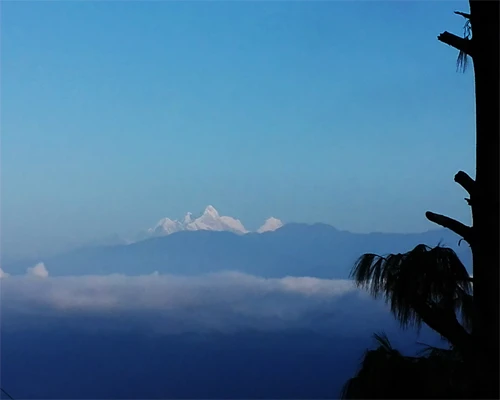Pilgrimage Center: Lumbini is one of the four most important pilgrimage sites in Buddhism, along with Bodh Gaya (where the Buddha attained enlightenment), Sarnath (where he gave his first sermon), and Kushinagar (where he attained parinirvana).
Lumbini is a sacred Buddhist pilgrimage site in the Rupandehi District of Nepal. It is well known as the birthplace of Siddhartha Gautama, who later became the Buddha and founded Buddhism. Lumbini is the most famous holy land for the Hindu and Buddhist religions.
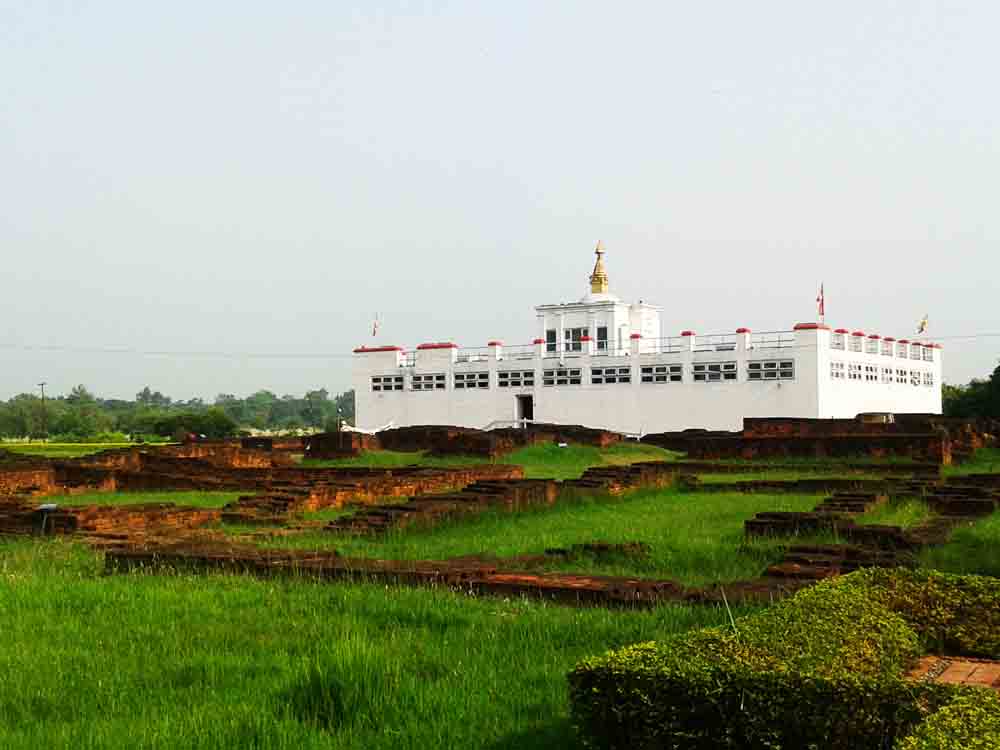
According to Buddhist tradition, the Lord Buddha was born here in 642 BC or 2556 years ago as Prince Siddhartha. His father was a king from Kapilavastu, and his Mother was Queen Maya Devi. By the time of the full Moon in May, Mayadevi was on the way to her parents’ home in Devadaha. At the same time, she started to feel labor pains because she took support by grabbing branches of the Shade tree. It was not in the hospital, not in the home; it was completely in the green grass garden where she gave birth to the present Buddha (Shakyamuni Buddha). As the Buddhist myth explained the Siddhartha Gautama stood up just after he was born and walked seven steps in each direction by proclaiming “This is my final rebirth" for peace, love, and compassion, which I want to expand all over the seven continents.
In 249 BC, the Buddhist-converted Emperor Ashoka visited Lumbini and constructed four stupas. Also, he had erected a stone pillar with the script written in the PALI language that the mighty Lord Sakyamuni Buddha had been born here, and the king Piyadasi (Ashoka) himself made the Royal visit. He also made Lumbini village a tax-free site and entitled it to eight parts like Niglihawa, Gothihawa, Sagarahawa, Araurakot, Sisahaniya, Kudan (Taulihawa), Tilaurakot, and Ramagrama.
The garden of the Buddha's birthplace was lost for a thousand years after the arrival of Islam and Hinduism. Monasteries and temples were built at Lumbini until the 9th century, after then Buddhism started to decline around the sites. The site was rediscovered only in 1895 when a German archaeologist came and kept an eye on Ashoka's Pillar and tried to identify it by its inscription. Records made by the Chinese pilgrim Fa Xian were also used in the process of identifying this religiously acclaimed site. Then Lumbini was designated a UNESCO cultural world heritage site in 1997.
Important things to see in Lumbini
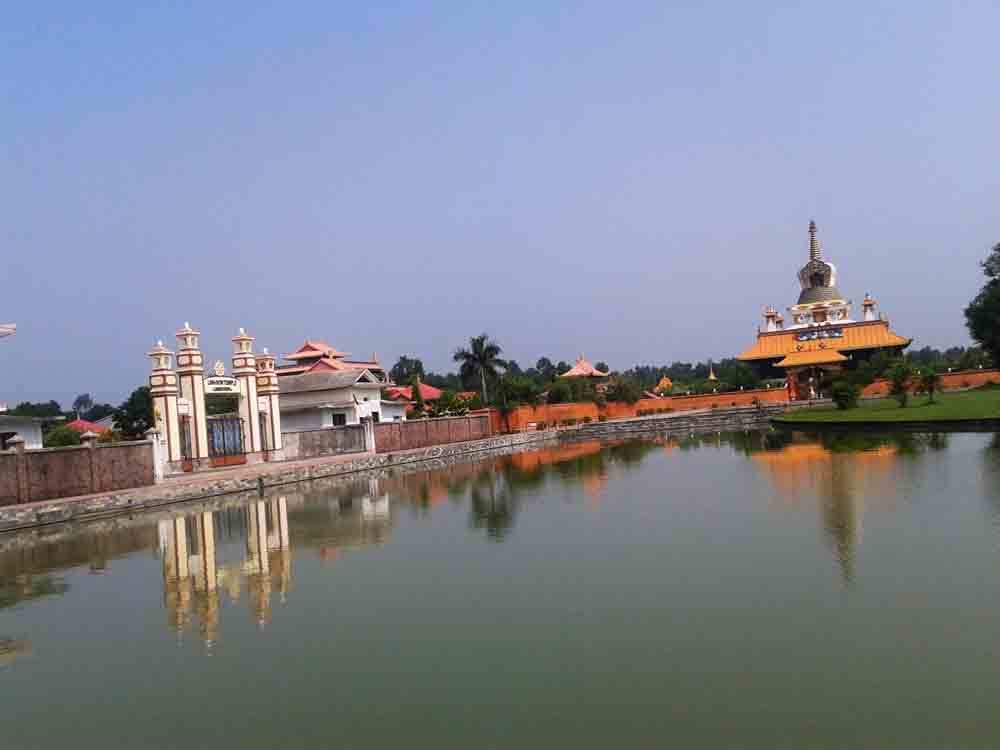
UNESCO World Heritage Site: Lumbini was designated a UNESCO World Heritage Site in 1997 due to its immense religious and historical significance. The area contains archaeological remains of monasteries, stupas, and other structures dating back to the 3rd century B.C
Maya Devi Temple: which enshrines the traditional site of the Buddha's birth, the modern temple consists mainly of a simple white building that protects ancient ruins, with the exact spot of the Buddha's birth identified. The current temple stands on the site of earlier temples and stupas, including the stupa built by Ashoka.
Birthplace of the Buddha: According to Buddhist tradition, Queen Maya Devi gave birth to Siddhartha Gautama in Lumbini in 623 B.C. The exact spot of his birth is believed to be within the Maya Devi Temple, a central feature of the sacred garden.
Sacred pool ( Puskarni Pool)
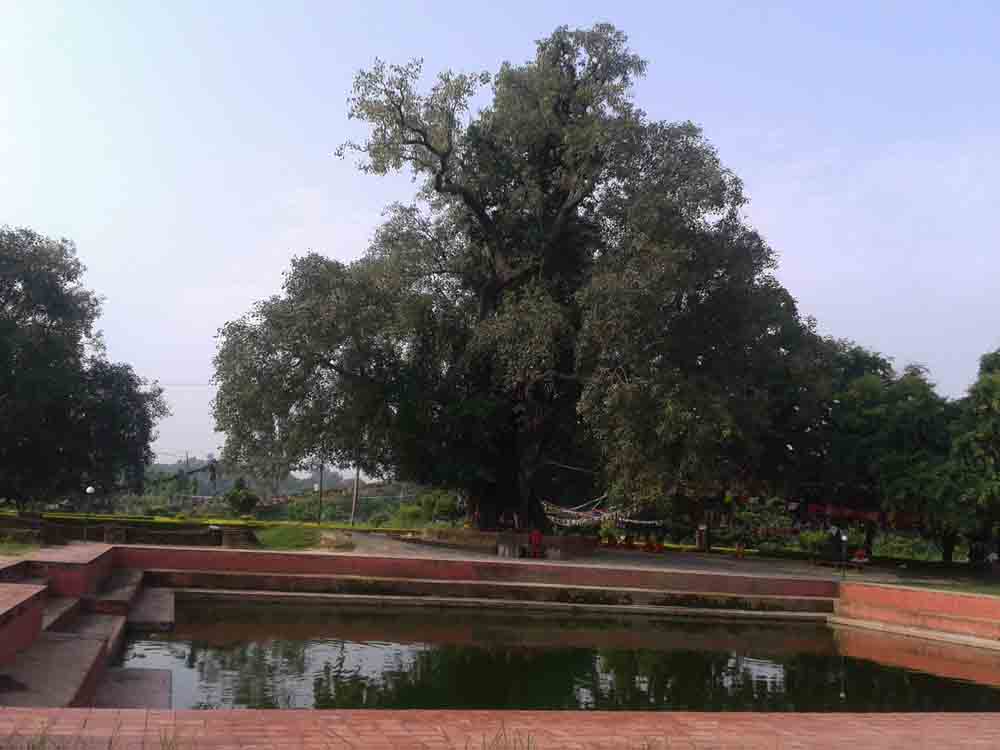
The myth believes that Maya Devi had bathed before giving birth in this pool because she felt hot and sweaty. Immediately, she gave birth to a boy, and that newborn baby was washed by his stepmother in this pool after his holistic proclamation.
Ashoka Pillar

A major piece of evidence confirming Lumbini as the Buddha's birthplace is the Ashoka Pillar. This sandstone pillar, erected by the Mauryan Emperor Ashoka in 249 B.C., bears an inscription that confirms his visit to the site and identifies it as the birthplace of Shakyamuni Buddha.
World Peace Stupa
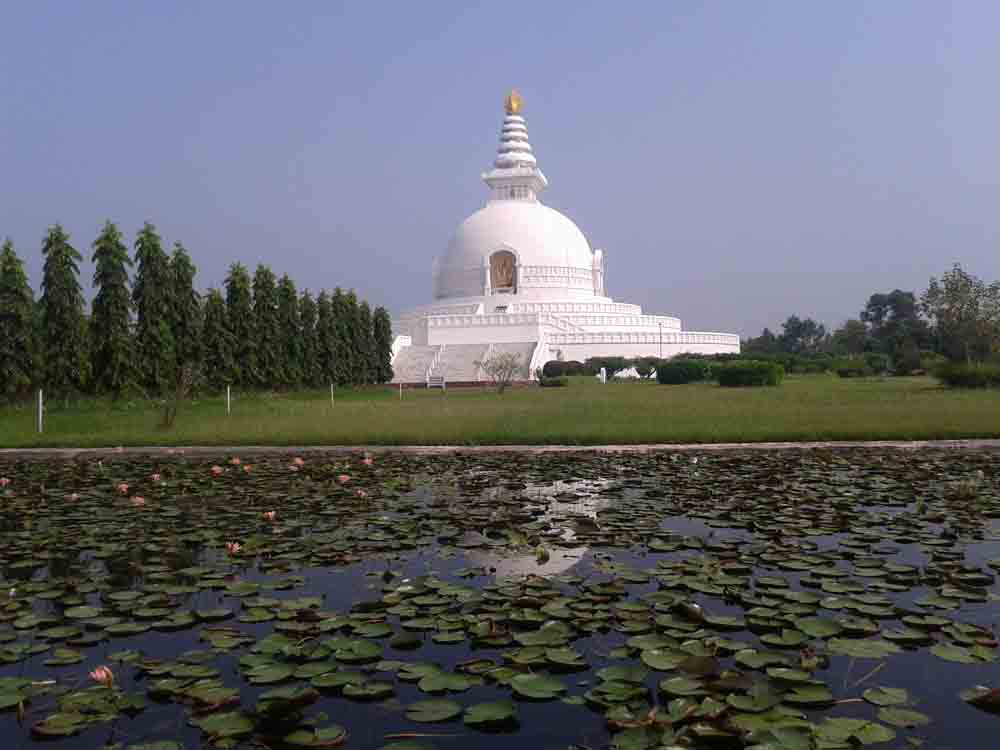
The Government of Japan built the World Peace Stupa for the faithful of peace and compassion.
Central channel and flame: straight ahead of the main existence of Maya Devi temple, the paved path leads to the central channel begins it is simply like a lake; it is a symbol of dignity and peace regularity. At the very beginning of the channels, the 24-hour burning flames are standing.
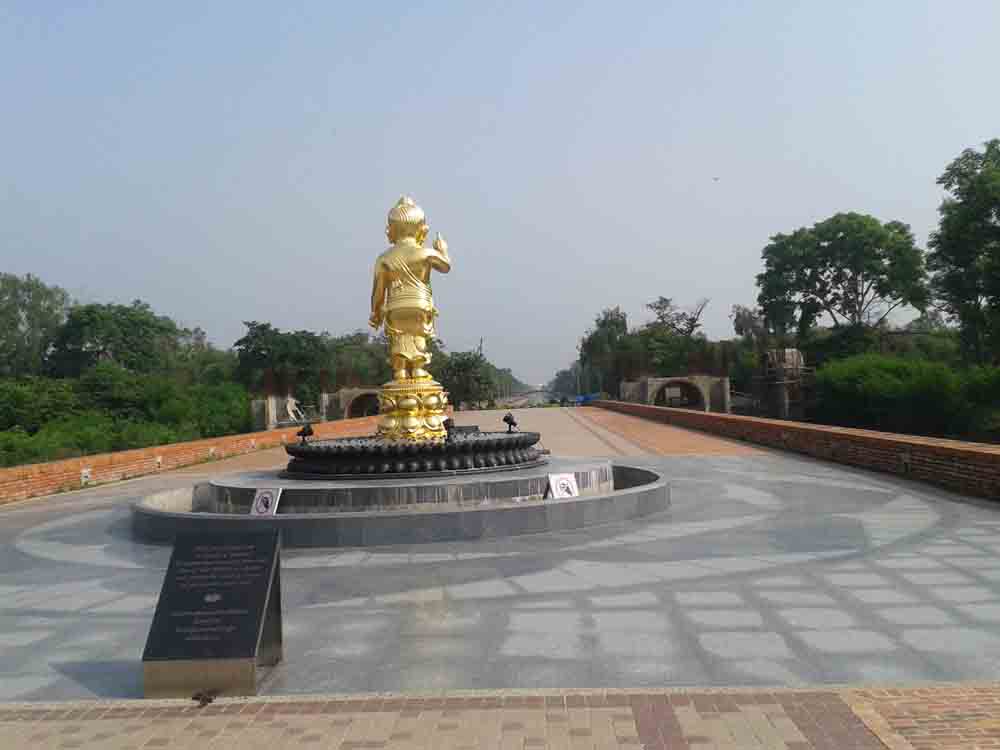
International Monastic Zone: Today, Lumbini is a major development project, with an international monastic zone that features monasteries and temples built by various Buddhist countries from around the world, including China, Thailand, Germany, and Vietnam. These monasteries showcase a diversity of architectural styles and Buddhist traditions.
Historical and Cultural Significance surrounding Lumbini
Taulihawa
It is located about 25 kilometers southwest of Lumbini, the UNESCO World Heritage Site and the birthplace of Gautama Buddha. Nowadays, it is the administrative center of the Kapilvastu District in the Lumbini Province of southern Nepal.
Taulihawa is a region of immense historical importance, especially for Buddhists. It is believed to be the ancient kingdom of the Shakya clan and the home of Prince Siddhartha Gautama, who later became the Buddha. He is said to have spent the first 29 years of his life in this area before embarking on his quest for enlightenment. The region is rich with archaeological sites, with more than 130 historical sites related to the Buddha's life.
- Tilaurakot: This is arguably the most significant site in the area. It is believed to be the ancient city of Kapilvastu, the capital of the Shakya kingdom and the palace where Prince Siddhartha lived. Excavations have revealed fortifications, a central walled complex, and other structures.
- Kapilvastu Museum: Located in the municipality, the museum houses various artifacts found during excavations, including coins, pottery, jewelry, and terracotta figures from different historical periods.
- Jagdishpur Reservoir and Sagarhawa: These are reservoirs that are popular for bird watching and offer a glimpse into the local ecosystem.
Gotihawa
Gotihawa is a significant archaeological and religious site located in the Kapilvastu District of Nepal. It is believed to be the birthplace of Krakuchhanda Buddha, one of the past Buddhas who preceded Siddhartha Gautama Buddha.
Key features and historical significance of Gotihawa:
- Krakuchhanda Buddha: According to Buddhist tradition, Gotihawa is the place where Krakuchhanda Buddha was born and attained enlightenment.
- Ashoka Pillar: Emperor Ashoka, a devout follower of Buddhism, visited the site in 249 BCE and erected a monolithic stone pillar to commemorate his visit and honor Krakuchhanda Buddha. The pillar, which is still standing in situ, is missing its upper portion and inscription. Chinese travelers like Fa-hsien and Hiuen Tsang mentioned the pillar in their accounts, noting that it was originally topped with a lion capital.
- Ancient Stupa: A large brick stupa, also built by Emperor Ashoka in the 3rd century BCE, is located at Gotihawa. Excavations have revealed that the stupa was expanded during the Saka and Kushana periods (1st century BCE to 3rd century CE).
- Archaeological Discoveries: Excavations at Gotihawa have unearthed ancient pottery, bricks, and other artifacts, with evidence of human activity dating back as far as the 10th-9th century BCE.
Niglihawa
Niglihawa is a significant archaeological and pilgrimage site in the Kapilvastu District of Nepal. Its primary historical importance lies in its association with Kanakamuni Buddha, one of the past Buddhas who preceded Gautama Buddha.
Key features and history of Niglihawa:
- Birthplace of Kanakamuni Buddha: Niglihawa is traditionally identified as the birthplace of Kanakamuni Buddha. According to ancient texts, he was born there in the home of a Brahmin named Yajndatta.
- Ashoka Pillar: The site is home to a broken Ashoka Pillar, erected by the Mauryan Emperor Ashoka in 249 BCE. The pillar's inscription, written in Brahmi script and Pali language, states that Ashoka visited the site and enlarged the stupa of Kanakamuni Buddha. The pillar also contains a later inscription from King Ripu Malla, dating to 1312 CE.
- Discovery: The pillar was rediscovered by German archaeologist Dr. Alois Fuhrer in 1895, who was also instrumental in the discovery of the nearby Lumbini Pillar.
- Location: Niglihawa is situated about 7 kilometers northeast of Taulihawa and approximately 20 kilometers northwest of Lumbini, the birthplace of Gautama Buddha. It is also referred to as Nigali Sagar, named after a large pond located at the site.
- Historical accounts: The significance of the Niglihawa stupa and pillar was also documented by the Chinese pilgrims Fa-Hien (5th century CE) and Xuanzang (7th century CE) in their travel accounts.
Kudan
Kudan is the the site where Buddha is said to have first met his family after his enlightenment.
Sagarhawa
Sagarhawa is a historical and archaeological site located in the Kapilvastu district of Nepal, approximately 10-12 kilometers north of Taulihawa. It is a significant location in Buddhist history, known as the site of the massacre of the Sakyas.
Here are some key facts about Sagarhawa:
- The Sagarhawa Massacre: According to ancient Buddhist literature, this is the place where King Virudhaka of Kosala, seeking revenge, massacred a large number of the Sakya people. The Sakyas were the clan of Prince Siddhartha, who would later become the Buddha. It's said that after the massacre, the bodies of the slain were buried here, and hundreds or even thousands of stupas were built in their memory.
- Archaeological Significance: The site is home to the ruins of an ancient pond, locally known as "Lumbu Sagar" (meaning "long pond"), and numerous stupas. Archaeological excavations have uncovered thousands of small relic stupas, arranged in symmetrical rows, and containing relics such as bones, gold, silver, and gemstones. The Chinese traveler Hiuen Tsang, who visited the site in 636 AD, also described the presence of many stupas, which corroborates the historical accounts.
- The Pond: The pond itself is a large, rectangular body of water, measuring about 1,059 feet long and 225 feet wide. The ancient ruins are primarily located on its western and southern banks.
- Location and Context: Sagarhawa is an important part of the broader Buddhist circuit in Nepal's Kapilvastu district, which includes other significant sites like Tilaurakot (the ancient capital city of Kapilvastu and home of Prince Siddhartha), Gotihawa (birthplace of Krakuchhanda Buddha), and Niglihawa (birthplace of Kanakamuni Buddha).
Devdaha
Devdaha is the UNESCO World Heritage site of Lumbini, the maternal home of the lord Buddha. It holds significant historical and religious importance, particularly concerning Buddhism. The name "Devdaha" comes from the Sanskrit words deva (god) and daha (pond), meaning "pond of the gods." According to legend, gods and saints used to bathe in this pond, and Prince Siddhartha himself is believed to have bathed in it during his visits.
Key Historical and Religious Significance
- Ancient Koliya Kingdom: Devdaha was the capital of the ancient Koliya kingdom. The Koliyas were a clan closely related to the Shakya clan of Kapilavastu, to which Siddhartha Gautama (the Buddha) belonged.
- Maternal Home of the Buddha: Devdaha is traditionally recognized as the maternal home of several key figures in the Buddha's life:
- Buddha's Visits: After his enlightenment, the Buddha is said to have visited Devdaha to resolve a conflict between the Shakya and Koliya clans over the Rohini River. He preached to the monks there and emphasized that familial bonds are more important than disputes over resources
Notable Sites and Attractions
- Queen Mayadevi: The Buddha's mother.
- Prajapati Gautami: The Buddha's stepmother and aunt.
- Princess Yasodhara: The Buddha's consort.
- Bhawanipur: Believed to be the ancient capital of Devdaha, this site contains a stone pillar, a statue of the Sun God, and an ancient well.
- Kanyamai Temple: A popular pilgrimage site.
- Devdaha Park: A park with a large statue of the Buddha.
- Pakari Tree: A symbolic tree that is a remnant of the Koliya era.
Ramagrama Stupa
- Ramagrama Stupa is a key Buddhist pilgrimage site. It is one of the eight original stupas that were built to house the corporeal relics of the Buddha after his death.
- Historical Significance: The stupa's location was lost for centuries until it was rediscovered in the late 19th century. Archaeological excavations have revealed structures and artifacts dating back to the Buddha's era
- Undisturbed Relics: According to Buddhist tradition, the Ramagrama Stupa is one of the only original eight stupas that have remained undisturbed. Legend says that when the Mauryan Emperor Ashoka (c. 3rd century BCE) attempted to open the stupa to redistribute the relics, he was prevented from doing so by the Nāgas, or serpent deities, who were guarding it.


